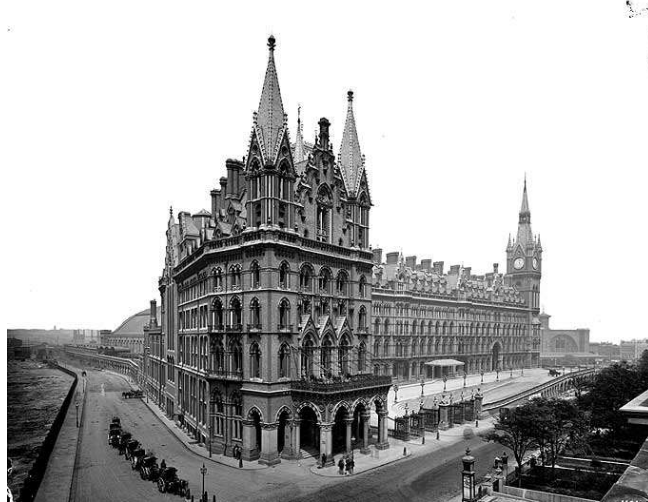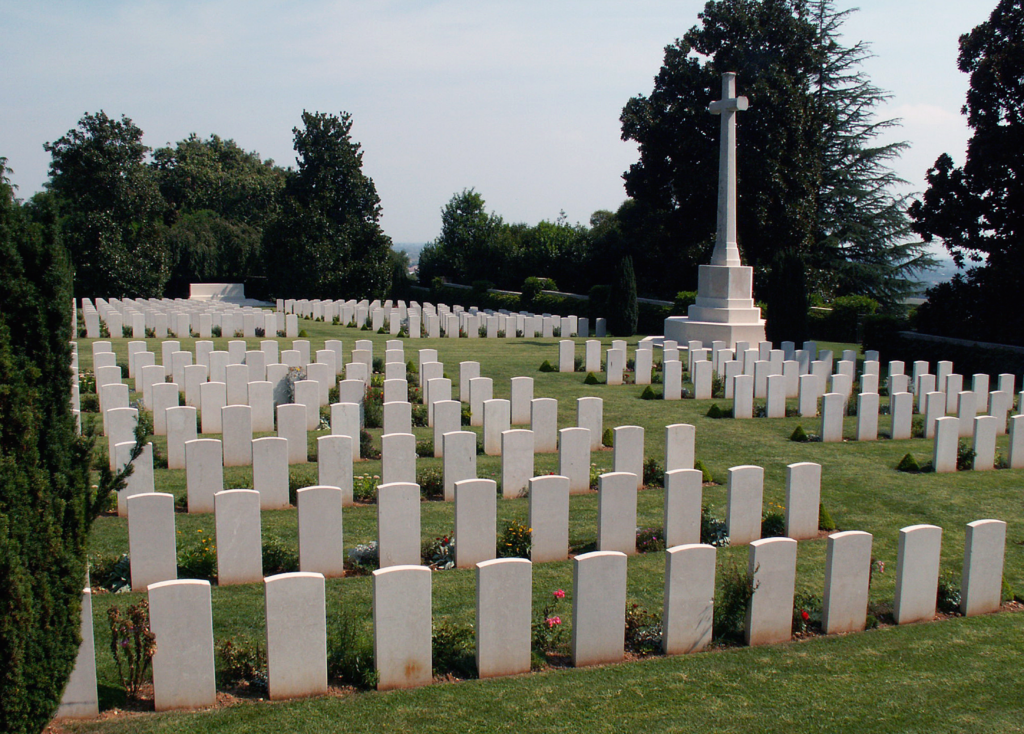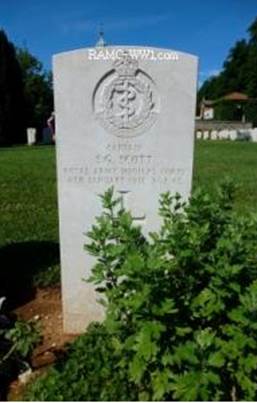Fact file:
Matriculated: 1893
Born: 11 March 1875
Died : 6 January 1918
Regiment: Royal Army Medical Corps
Grave/Memorial: Giavera British Cemetery (Arcade): 4.A.7
Family background
b. 11 March 1875 in Battersea. Eldest son (of four boys and five girls) of Canon Samuel Gilbert Scott (1847–1916) and Louisa Scott (née Soames) (1849–1932) (m. 1874). In 1881 the family was living in St Saviour’s Vicarage, Battersea, with five servants; in 1901 and 1911 they were living at The Rectory, Havant, Hampshire (five servants).
Parents and antecedents
Scott’s father was a Demy at Magdalen 1865–1870 (3rd Class in Literae Humaniores in 1869), and an athlete winning the University Mile in 1867 and the Amateur Championship Mile in the same year. He was curate of St Mary’s, Battersea 1873–77; Vicar of St Saviour’s, Battersea 1877–83; Rector of Woolwich 1883–92; Rural Dean of Woolwich 1885–92, of Landport 1896–1900 and of Havant 1900–1916.
Samuel Gilbert’s father was Samuel King Scott (1819–65) a GP in Brighton and the brother of Sir George Gilbert Scott (1811–1878) (who was therefore Scott’s great-uncle). Sir George was a prolific and well-known architect, who first specialized in workhouse design at the time when many were being built in response to the Poor Law Amendment Act of 1834. His first workhouse was built in Winslow, Buckinghamshire, in 1835. But under the influence of Augustus Welby Northmore Pugin (1812–52), he came to specialize in ecclesiastical architecture: he became the leader of the architectural Gothic Revival and designed or restored hundreds of churches, cathedrals and abbeys, including the chapels of Exeter College, Oxford, and St John’s College, Cambridge. Nevertheless, Scott himself was most proud of his design for the Midland Grand Hotel at St Pancras (1873).

View from the south-west of the Midland Grand Hotel, Euston Road, St Pancras, London (12 September 1881)
(With kind permission (6352) of Historic England)
Together with his partner William Bonython Moffatt (1812–87), Sir George was also responsible for the design of the Martyr’s Memorial to Thomas Cranmer (1489–1556), Nicholas Ridley (c.1500–55), and Hugh Latimer (1487–1555), which stands near the site where they were burned as heretics in Oxford. Although he submitted, in 1872, a design for a new quadrangle on the Magdalen Hall site at Magdalen College, it was never built. But his grandson, Sir Giles Gilbert Scott (1880–1960), Samuel Geoffrey’s second cousin and another successful architect, who designed inter alia Liverpool’s Anglican cathedral, had a much closer relationship with Magdalen, being the architect of Longwall ranges.
Scott’s mother was the daughter of William Aldwin Soames (1792–1871), a merchant.
Siblings and their families
Brother of:
(1) Percy Melville Scott (1877–1950); married (1909, in China) Winifred Julia Woodforde (1875–1959); three children;
(2) Ruth Eveline Scott (born 1879, died 1917 in China); married (1910, in China) Frederick Stephen Hughes (1875–1920); three children;
(3) Laura Mabel Scott (1880–1968); married (1918) George Glendinning Wight (1884–1976); two children;
(4) Ellen Constance Scott (1883–1970); married (1906) Bernard William Keymer (1876–1925); seven children;
(5) Stanley Arthur Scott (1886–1887);
(6) Raymond Aldwin Scott (1887–1964); married (1933) Lettice Wright (1895–1973);
(7) Bertha Mary Scott (born 1889);
(8) Ethel Scott (1891–1892).
Percy Melville was a Commoner at Magdalen from 1896 to 1901 (2nd Class in Literae Humaniores in 1900). He was ordained in 1903 and worked in Southampton and Leeds before going to China in 1909, where he was stationed in Peking (Beijing) and was acting Chaplain to the British Legation from 1910–15. But his longest posting was in Tatung Fu (1923–1931), where he was involved in the siege by the Kuominchun forces in 1926; he went to them, at the request of the city elders, on a peace mission, which was unsuccessful. He returned to England in 1931, serving as vicar of several parishes before his death in 1950.
Frederick Stephen Hughes was an Anglican priest, who in 1901 was secretary of Oxford House, the University Settlement in Bethnal Green. He went out to China before the war and remained there, holding various posts in North China. His wife died in China in 1917, probably in childbirth. Frederick was involved in the rescue of several hundred Chinese from floods. This affected his health and he returned to England with his two surviving children, and died shortly after. He was the author of several books including Where is Christ? A Question for Christians (reprinted in 2008).
George Glendinning Wight was an accountant.
Bernard William Keymer was a clergyman in the established church. During the war he was first a temporary chaplain to the forces (4th class), serving with the Royal Flying Corps; he was twice mentioned in dispatches (London Gazette, no. 30,101, 29 May 1917, p. 5,324; and no. 31,088, 27 December 1918, p. 15,215) and was awarded the OBE (military) (LG, no. 31,092, 31 December 1918, p. 8). In 1919 he was appointed Temporary Deputy-Chaplain-in-Chief to the Forces with the rank of Colonel and shortly afterwards transferred in the same capacity to the Royal Air Force (formed 1 April 1918) with the rank of Squadron Leader. One of his sons, Michael, served as a Sergeant-Pilot with 65 (East India) Squadron at RAF Hornchurch, Essex, and was shot down on 22 August 1940, aged 24, by a Messerschmidt 109 while flying his Spitfire Mk 1 over the village of Bazinghen, France, three miles south-east of Cap Griz-Nez. An eye-witness later testified that although badly injured, he parachuted to safety and was murdered by a German officer on landing. He is now buried in the graveyard at Bazinghen. Another son, John Gilbert, also served as a Sergeant-Pilot with 149 (East India) Squadron at RAF Mildenhall, Suffolk. Together with the other four members of his crew, he was lost on 10 May 1941, aged 28, over the North Sea just west of Wesselburen, Schleswig-Holstein, north Germany, while returning in his Wellington Mk 1c bomber from a 119-aircraft raid on the docks at Hamburg and the power station at nearby Altona. He has no known grave.
Raymond Aldwin was commissioned in the Duke of Wellington’s Regiment in 1908 and retired with the rank of Captain in 1926. In 1933 he married his cousin Lettice Wright who was also the half-sister of his sister-in-law Marjory (see below).
Wife and children
Scott’s wife was Marjory Wright (1877–1962) (m. 1903); they had no children. In 1911 they lived in Portland Road, Oxford (one servant); later at 20, Charlbury Road, Oxford. Marjory was the daughter of a Cheshire solicitor, Albert Tomlinson Wright (1845–1911) and his first wife Fanny Hughes, née Holberton (1846–1881). At the time of the 1911 Census she and her step-mother, Emily Wright (née Scott, 1859–1947), were boarders at the Girls Friendly Society Lodge, Church Street, Birmingham. Since her father was in a private hospital in Newhall Street, Birmingham, at the time of the Census and died shortly after, they were probably in Birmingham during his final days. Emily Wright was the sister of Samuel Gilbert Scott and so both the aunt and the stepmother-in-law of Samuel Geoffrey.
Education and professional life
Scott attended Albion House Preparatory School, Margate, Kent (founded before 1881; also known as Mr Schimmelman(n)’s Preparatory School for Eton) from c.1881 to 1888, and then, from 1888 to 1893, Clifton College, President Warren’s old school. He passed Responsions in Trinity Term 1893 before matriculating at Magdalen as a Commoner on 19 October 1893, and then took an Additional Paper (Livy) in Hilary Term 1894, presumably to avoid taking the Classical Literature part of the First Public Examination. He took the second part, Holy Scripture, in Michaelmas Term 1894, but between Michaelmas Term 1893 and Trinity Term 1895 he also studied for the Preliminary Examination in Natural Science (Chemistry, Botany, Morphology, and Mechanics and Physics). In Trinity Term 1897 he was awarded a 3rd in Natural Sciences (Physiology) and he took his BA on 21 October 1897. He then studied at St Thomas’s Hospital and took his MA and BM in 1902. After the War, R.T. Gunther wrote of him:
His bent had always been towards laboratory work, and, after helping the Home Office inquiry into ankylostomiasis in Cornwall, he began a very happy married life, and was appointed Demonstrator of Pathology at Yorkshire College, Leeds in 1903 (University of Leeds from 1904). Here he remained for five years until, in 1908, he was called to succeed Dr. Gustav Mann as Senior Demonstrator in Physiology with charge of the Histological Laboratory at Oxford. No selection could have been more appropriate, both for the man and for the office. Scott had been a close friend and pupil of Mann’s, and was full of that fine tradition for making Histology something more than minute anatomy, which is familiar to Oxford students for the last twenty years. He worked happily and enthusiastically for eight years […].
Another obituarist wrote:
Scott was essentially a histologist, and he envisaged his science along the lines which will no doubt lead to its revival in this country from the comparative neglect into which a soulless micro-anatomy had rather deservedly brought it. His scheme was to graft into this a generalized micro-chemistry in a wide sense, and if he planned on a pretty generous scale, it was part of his genial trust in the goodness of the way in which the world is arranged. His published work bears no relation to his long laborious days; but his store of learning on anything histological was always at the disposal of his friends, and he knew that the best way to get anyone to try a new stain is to give him some of it. Pupils of his who afterwards came to morbid histology were apt to ask rather awkward questions about methods of fixation and suchlike, instead of wondering in a bewildered way whether the little black dots were nuclei, and what the thin red line might be. It seems impossible that Scott should have had an enemy.
H.M. Vernon in the Biochemical Journal wrote: “Scott practically lived in the laboratory, as he did not trouble about such mundane matters as lunch, and very rarely took a holiday” – an impression which is borne out by his informal look in the photo below. Vernon then continued: “At the outbreak of war Scott took up a temporary appointment as house surgeon at the Radcliffe Infirmary, Oxford […] finding it was possible to obtain a substitute for his teaching work, he thought it his duty to volunteer for a commission in the R.A.M.C.” He also held an appointment in the Throat Department of St Thomas’s Hospital.
War service
Scott joined the Royal Army Medical Corps on 1 July 1916, at the Royal Victoria Hospital (Netley Hospital), near Southampton, which was purpose-built as a military hospital in 1856 with the main building being the longest in the world at that time.
After initial training here he was posted to France and attached to the 7th Divisional Train in 1917. The Divisional Train was run by the Army Service Corps and supplied all the provisions for the troops in the Division. The Divisional Train’s war diary does not mention the arrival of Scott nor his departure, but it does note that on 15 November Captain Judson, RAMC, was posted to the Train, possibly as a replacement for Scott.
With fewer troops required on the Russian front, German troops were diverted to aid their Austrian allies on the Italian front, where fighting had almost reached the stalemate of the Western Front. On 17 October 1917 the Austrians and Germans defeated the Italians in the Battle of Caporetto and the Italians withdrew to a defensive line near Venice. In late November British and French troops arrived in Italy to support their allies on this front. The 7th and 41st divisions were two of the five divisions of the British Expeditionary Force that was commanded by General (Field Marshall in 1919) Herbert Charles Onslow Plumer (1st Viscount Plumer 1919) (1857–1932).
From 16 to 18 November 1917 the 7th Divisional Train entrained at Maresquel and on 22 November it detrained at Legnago so that its HQ could march to Cologna with the body of the British 7th Division, which was congregating in the Cologna, Pressano and Roveredo areas, east of Lake Garda at the western end of the defensive line. Although Scott had gone to Italy as a member of the staff of the 7th Divisional Train, shortly after his arrival he was seconded to the 41st Divisional Train. The 41st Division took over a sector of the front line behind the River Piave, north-west of Treviso, between 30 November and early 2 December, that is, at the eastern end of the defensive line. According to Vernon’s obituary of Scott, it was here that he “succumbed in a few days to an attack of pneumonia”, and on 6 January 1918 he died of his illness at a casualty clearing station, aged 43. He was buried in Giavera British Cemetery (Arcade) (12 km east of Montebelluna), Treviso in grave 4.A.7. He left £5,026 12s 5d.

Giavera British Cemetery, Treviso
(Photo courtesy of Mr Steve Rogers; © The War Graves Photographic Project)
Bibliography
For the books and archives referred to here in short form, refer to the Slow Dusk Bibliography and Archival Sources.
Special acknowledgements:
*Philip Roberts, RIBA, FRSA, Oxfordshire, for the photographs of Samuel Gilbert Scott and Samuel King Scott.
Printed sources:
R[obert] T. Gunther, The Daubeny Laboratory Register 1904–1915 (Oxford: Oxford University Press, 1916), p. 236.
[Anon.], ‘The Casualty List: Died’ [brief death notice], The Lancet, no. 4,925, vol. 1 (19 January 1918), p. 113.
H.M. Vernon, ‘Samuel Geoffrey Scott’ [obituary], Biochemical Journal, 12, no. 1/2 (1918), pp. 3–4.
A.E.B., ‘Samuel Geoffrey Scott, B.M.’ [obituary and photo], The Journal of Pathology and Bacteriology, 23, no. 1 (1920), pp. 115–16.
Günther (1924), pp. 437–8.
W.J.O’Connor, British Physiologists 1885–1914: A Biographical Dictionary (Manchester: Manchester University Press, 1991), p. 87.
Roger White, assisted by Robin Darwall-Smith, The Architectural Drawings of Magdalen College, Oxford, a Catalogue (Oxford: OUP, 2001), pp. 151–2, 184–92.
Archival sources:
OUA: UR 2/1/22.
WO95/1649.
Scientific articles by Samuel Scott:
[With E.M. Corner], ‘A Mixed Tumour of (1) Lip, and (2) of the Submaxillary Gland, probably Endothelial in Origin’, Transactions of the Pathological Society of London, 54 [no issue number] (29 April 1902), pp. 345–9.
[With E.M. Corner], ‘Endotheliomata’, Transactions of the Pathological Society of London, 54 (1903), p. 375.
[With H. Littlewood and W.H. Maxwell Telling], ‘A Case of Multiple Neurofibromatosis’, The Lancet, 165, no. 4,238 (8 April 1905), pp. 921–3.
[With W.H. Maxwell Telling], ‘A Case of Infantile Splenic Anaemia’, The Lancet, 165, no. 4,268 (1905), pp. 1638–40.
‘A Case of Subacute Atrophy of the Liver: De atrophia hepatis subacuta’, Transactions of the Pathological Society of London, 56 (4 April 1905), pp. 298–307.
‘Change of Type in Leukaemia’, The Lancet, no. 4,396, vol. 2 (1907), pp. 1,537–43.
‘Obstruction Atrophy of the Pancreas’, The Journal of Pathology and Bacteriology, 11, no. 4 (1906), pp. 458–61.
[With T.O. Thomson and J.L. Hydrick], ‘On Romanowsky Staining for Blood Cells’, Folia Haematologica, 12, part 1, no. 2 (24 October 1911), pp. 302–04.
‘On Successive Double Staining for Histological Purposes’, The Journal of Pathology and Bacteriology, 16, no. 1 (1911), pp. 384–409 (esp. 390–8).






